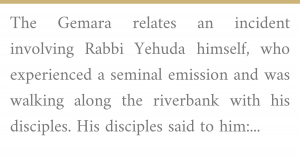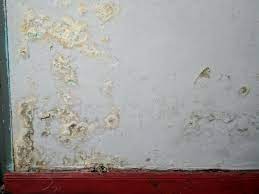Tazria – Metzoira 2021: Leprosy? Not Exactly
by devadmin | April 15, 2021 8:46 pm
Leprosy: not exactly!
 In late breaking news as the Ois finishes this week’s post one day early (traveling tomorrow), and in a very local Lawrence / Woodmere shidduch a huge mazel tov to our friends Carine and Bruce Schneider -nicer and more giving people hard to find- upon the engagement of their amazing son Jeremy to Sara Kaufman, she the beautiful daughter of Shai and Adam Kaufman. We look forward to participating in this great simcha. May Sara and Jeremy be zoche (merit) to be at each other’s side, in blissful marriage for many decades to come.
In late breaking news as the Ois finishes this week’s post one day early (traveling tomorrow), and in a very local Lawrence / Woodmere shidduch a huge mazel tov to our friends Carine and Bruce Schneider -nicer and more giving people hard to find- upon the engagement of their amazing son Jeremy to Sara Kaufman, she the beautiful daughter of Shai and Adam Kaufman. We look forward to participating in this great simcha. May Sara and Jeremy be zoche (merit) to be at each other’s side, in blissful marriage for many decades to come.
And this week we shout out Dr. Shelly Green, https://www.greenlaw.me. Why? Because though this review goes out and is read weekly (at least parts of it) by many hundreds of thousands all over the world, only one reader, attorney and doctor (such nachas to his parents and family) Sheldon Green, chapped one mistake made by the Ois in last week’s parsha review. His text just after shabbis, is quoted below. He is correct; kudos to you. Education!
Gut vuch
Shelly Green here… Quick correction on your issue this week… On page 8 you say “postpartum, the medrish tells us…” Postpartum means after birth/after delivery and that’s not what we’re talking about here… I believe you meant to say postmortem… after death Just saying…
Shoin, before we mention seminal and other emissions, a topic discussed in this week’s parsha, one, most you know too well -say it’s not so, but it is- let’s begin here. Long before the CDC and others, in early 2020, issued quarantine guidelines as a way to help slow the spread of the coronavirus -in fact thousands of years before- the RBSO first introduced us to the concept of the quarantine. When? Back in the year 2448 or perhaps it was already 2449. Where? In this week’s doubleheader parshas of Tazia and Metzroira. A quick summary of both follows, ober, Ershtens (firstly), a shtikel overview on the history of quarantining.
According to those with some knowledge on the matter (Wikipedia and others), the practice of quarantining as we know it began during the 14th century in an effort to protect coastal cities from plague epidemics. Ships arriving in Venice from infected ports were required to sit at anchor for 40 days before landing. With ships come seamen, with seaman comes semen, and shoin. This practice, called quarantine, was derived from the Italian words “quaranta giorni” which mean 40 days.
The Public Health Service Act of 1944 established the federal government’s quarantine authority for the first time. The act gave the U.S. Public Health Service (PHS) responsibility for preventing the introduction, transmission, and spread of communicable diseases from foreign countries into the United States. Now you know and let us get back to the heylige Toirah and review of our parshas.
Welcome to the spring double-header Parshas of Tazria- Metzoira where we will find the following discussed in expanded colorful detail. Speaking of colorful, it does appear that color, specifically the colors red and white, were one of the determinants for quarantining. We need not, in year 11 of the heylige Ois’s reviews, go over the entire parsha, ober let us chazer what the RBSO told Moise to teach the Yiddin about a variety of skin diseases and honorable and dishonorable discharges. We speak not from military service; instead, we will be learning about the daily -and avada more often among the younger men, if you chap, emissions. Ober, before all that, let’s highlight the parsha pearls.
In Perek 12, pisukim 1-8, the RBSO describes the rituals of purification for a woman after childbirth. Childbirth renders the mother impure and also requires her to bring a sin offering korban. The RBSO sets forth the methods for diagnosing and treating a variety of skin diseases, each a tzora’as (a leprous affection of assorts but not really leprosy as we will read below), as well as those for purifying clothing in the very next perek (13: 1-59). And if that weren’t enough, Priestly rituals performed by the kohanim to diagnose and declare the tzora’as- when it afflicts humans, are described in 14:1-32. Rituals to rid dwelling places of tzora’as- are presented in pisukim 33-57. For good measure and efsher to keep one interested, the parsha -as mentioned above- denotes male impurities resulting from a penile discharge or seminal emission. Seemingly, every drip counts; double dripping adds a new title. Those can be found in Perek 55:1-18. And lest you think that only males have discharges, and not be left out, or accused of being sexist, the parsha concludes with accounts of female impurities caused by a discharge of blood and other zachin. Those in pisukim 19-33.
 The bottom line: when a person saw that he may be coming down with tzara’as, he consulted with his local koihen, who examined him. Diagnosis was somewhat counterintuitive. A person who had a few spots was rendered infected and labeled a metzora. Ober, if spots covered his whole body, he was not considered infected; how and why that worked, ver veyst? In the good news department: an infected person could be granted a grace period if they were about to get married. Vus epes (why)? Seemingly it was important to the RBSO that marriages be consummated; sex above all!
The bottom line: when a person saw that he may be coming down with tzara’as, he consulted with his local koihen, who examined him. Diagnosis was somewhat counterintuitive. A person who had a few spots was rendered infected and labeled a metzora. Ober, if spots covered his whole body, he was not considered infected; how and why that worked, ver veyst? In the good news department: an infected person could be granted a grace period if they were about to get married. Vus epes (why)? Seemingly it was important to the RBSO that marriages be consummated; sex above all!
Another bottom line: kimat the entirety of both parshas of Tazria-Metzoira deal with the laws governing tzora’as, an enigmatic affliction which takes the form of a skin disease in people, but which can also afflict clothing and houses. As to emissions and dishonorable charges, they too are discussed and also render a person impure who needs to clean up his/her act. Due to its symptoms of skin discoloration and the requirement that the victim be quarantined, tzora’as has often been mistakenly identified as leprosy. However, it is not – according to most- caused by infection or a biological imbalance; rather, it is the physical but supernatural manifestation of an individual’s spiritual malaise. What that means, ver veyst? Let’s try again: It is a Divine-sent plague that struck a man or a woman. Why, when, where, how and other questions, are hotly debated but the bottom line is azoy: one stricken with tzora’as on his house, clothing, or body, need not visit the doctor or the hospital; only the RBSO can help. Dermatologists like Abe Abbitan might argue otherwise. How that works and what that all means, ver veyst? Another factoid: one stricken with tzora’as needed to go through a series of ritual cleansings, inspections, and quarantining before being allowed back into the community.
Our sages of yore understood tzora’as in a variety of ways. Several passages to a direct connection between particular sins and tzora’as are found in the heylige Gemora (Ayrichin 15-16), just after the mishna outlines the laws of the motzi shem-ra (slanderer). Let’s read a few: said “Rebbei Yossi Ben Zimra: Whoever speaks loshon horo – tzara’as infections come upon him…” “Reish Lakish said: ‘This shall be the ritual for a metzora’ – this shall be the ritual for the ‘motzi shem ra.'” “Rav Shemuel bar Nachmani said in the name of Rabbi Yochanan: Tzara’as comes on account of seven things: 1) lashon ha-ra; 2) murder; 3) false oaths; 4) immorality; 5) arrogance; 6) theft; 7) stinginess.”
The final shtikel Gemora continues by citing Scriptural proofs for each sin mentioned. Indeed, several events in heylige Toirah and the Novee (Tanach) seem to prove that tzara’as served as a divine punishment for various forms of wrongdoing. Miriam was stricken with tzara’as for speaking against Moishe (Bamidbar 12); Geichazi was punished for his greed and false oath to Elisha (Melochim II 5); Uziyahu was punished with tzara’as for offering incense in the Beis Hamikdash in defiance of the koihanim (Divrei Ha-yomim II 26:16-21). The bottom line: our sages decided -why, ver veyst- that tzara’as came about as a punishment and such logic parallels their perspective on other forms of disaster that befall an individual or the community as a punishment for a certain transgression or several transgressions. Veyter.
The heylige Gemora (Ayrichin 16a) lists seven reasons one might be afflicted with the disease: most of you are experts -say it’s not so- and all too familiar with the list. The big seven are: gossip, murder, perjury, forbidden sexual relationships, arrogance, theft, and envy. Interestingly and though, one would think that murder and forbidden sexual relations (two of the big tree) would pique the interest of our exegetes and lots would be written in the heylige Gemora and medrish to connect them to tzora’as, modern and contemporary commentators, focus on gossip only, connecting the word metzoira, a person afflicted with the condition, to motzi-shem-ra, a person guilty of slander or libel. Is this the right pshat? Ver veyst? It’s certainly enough to scare the color out of anyone and have him/her look as if they are afflicted. The bottom line: Throughout the heylige Gemora and medrish, chazal (our sages) view tzora’as as a punishment for various transgressions involving interpersonal misconduct, particularly the sin of loshoin ha-ra (slander/gossip, both part of loshon horo). Why the others on the list got a pass, ver veyst?
 Ober is that emes? Says who that tzora’as was connected to slander and other types of loshoin horo? And what happened to tzora’as? Has it been discontinued? Extinct efsher? Why has it disappeared? Have people stopped speaking loshon horo? Of course not! Banish the thought! The world will certainly come to an end before loshoin horo disappears. Moreover, does the heylige Toirah mention such a connection? It does not! In fact, throughout the entirety of the tzora’as section -kimat two entire parshas- the text of the heylige Toirah makes no mention -silent mamish- of ethical background and misconduct to the arrival of tzora’as, or its cure. We find not even an allusion to any sin preceding the onset of tzora’as, nor do we read of any instruction that the metzoira pray or repent during his period of isolation outside the camp. The heylige Toirah never hinges the cure from tzora’as on the patient’s conduct or awareness. Oib azoy (If that’s so, and seemingly it is), why in fact did our sages and other commentators take expanded literary license and connect them? Was this all but a scare tactic?
Ober is that emes? Says who that tzora’as was connected to slander and other types of loshoin horo? And what happened to tzora’as? Has it been discontinued? Extinct efsher? Why has it disappeared? Have people stopped speaking loshon horo? Of course not! Banish the thought! The world will certainly come to an end before loshoin horo disappears. Moreover, does the heylige Toirah mention such a connection? It does not! In fact, throughout the entirety of the tzora’as section -kimat two entire parshas- the text of the heylige Toirah makes no mention -silent mamish- of ethical background and misconduct to the arrival of tzora’as, or its cure. We find not even an allusion to any sin preceding the onset of tzora’as, nor do we read of any instruction that the metzoira pray or repent during his period of isolation outside the camp. The heylige Toirah never hinges the cure from tzora’as on the patient’s conduct or awareness. Oib azoy (If that’s so, and seemingly it is), why in fact did our sages and other commentators take expanded literary license and connect them? Was this all but a scare tactic?
Let’s read this from our sages of the heylige Gemora (Ayrichin 16a) who teach us azoy: Tzora’as was not meant to replace the official punishment of the particular sin that one had transgressed. Limoshol (by way of example), someone who committed adultery or murder in the presence of witnesses, was due -so the heylige Toirah teaches us elsewhere- to receive the death sentence, and would -back then- indeed have so been sentenced. Ober, let’s say that murder took place in the absence of eyewitnesses, or, that the lights were out and the shades drawn over at the motel where the adultery took place, and there were no witnesses present, then, the perpetrator and the person perpetrated, if you chap, would be magically stricken with tzora’as. The bottom line according to this Gemora is that the RBSO sees right through the drawn curtains, He’s the witness. Says the Ramban: the Divine nature of Tzora’as is clearly indicated by the fact that it first struck one’s house and one’s clothes, a phenomenon that can in no way be attributed to natural means by any stretch of the imagination. Moreover, the progressive order of the strokes, first the house, then the clothes and finally the body (each stage becoming more personal) indicate a meticulously planned Divine operation. And all this is enhanced by the fact that it departed the moment the sufferer did teshuvah.
Speaking of homes being infected with tzora’as (the phenomenon of nigai batim), and based on all the Ois found on the subject, tzara’as affliction of houses, is less well known and does not appear anywhere else in the heylige Toirah. Some claim that it is just theoretical; at least one sage in the heylige Gemora (Sanhedrin 71a) states that it “never was and never will be,” and that it was written in the Toirah only that we may “expound upon it and receive a reward.” Of course, elsewhere in the Gemora we read farkert; houses infected with tzora’as was real and in such instances, it must be emptied of its contents before it is examined by a koihen. What sin did the house commit? Why empty its contents? Did the walls sin? Or, efsher the bed?
 The technical reason given for evacuating one’s possessions is that once the koihen declares the house to have tzara’as, the contents of the house become tamei, ritually impure. The RBSO avada knew how hard it was to replace furniture and therefore gave the Yiddin a ‘content loophole. Should one see tzora’as on the walls of the house, don’t call the inspector until you empty the house. On the other hand, the heylige Gemora (Yoma 11b) chapped azoy: publicly emptying a home with nigai batim fits the crime that caused the affliction. They posit that house leprosy was caused when the owners of the house refuse to lend a tool, instead, claiming that they do not own such an instrument. The tzara’as then forced the unwilling lenders to publicly display their possessions, exposing their deceit and shaming them for their refusal to share resources with the community. Efsher we can kler that the owner’s own tool, if you chap, was abused causing the walls of the house to become infected.
The technical reason given for evacuating one’s possessions is that once the koihen declares the house to have tzara’as, the contents of the house become tamei, ritually impure. The RBSO avada knew how hard it was to replace furniture and therefore gave the Yiddin a ‘content loophole. Should one see tzora’as on the walls of the house, don’t call the inspector until you empty the house. On the other hand, the heylige Gemora (Yoma 11b) chapped azoy: publicly emptying a home with nigai batim fits the crime that caused the affliction. They posit that house leprosy was caused when the owners of the house refuse to lend a tool, instead, claiming that they do not own such an instrument. The tzara’as then forced the unwilling lenders to publicly display their possessions, exposing their deceit and shaming them for their refusal to share resources with the community. Efsher we can kler that the owner’s own tool, if you chap, was abused causing the walls of the house to become infected.
 Ober we ask again azoy: has loshoin horo abated? Has adultery stopped? Have people -say it’s not so- resorted to bedding their own spouses? Mistama not! Oib azoy, what happened to tzora’as as a form of divine punishment? Shouldn’t we all be walking around with tzora’as? Do any of us even know even one person who never speaks or listens to loshoin horo? Mistama not! Farkert: most of us know many who speak it daily. What happened to tzora’as as a form of punishment? Lest you think that this is a bomb kasha, it’s not as the Ramban asks and addresses it azoy: it is as a result of the Divine nature of tzora’as that it no longer exists. Like the water of the Soitah, a stunning miracle in its own right, tzora’as was the RBSO’s way of maintaining the moral purity of the camp of the Yiddin while in the midbar. It was G-d’s way of eliminating, first and foremost, evil speech from K’lal Yisroel. As long as the Yiddin strove to retain a high level of purity in body (morality) and soul (pure speech), He helped them to attain that goal. How? By eliminating those who were lax in these areas, or by forcing them to reassess their values, to help bring them back to their senses, using tzora’as as a lever. Ober, when the nation as a whole stopped striving towards those ideals, the RBSO seemingly withdrew, suspended or forever eliminated tzora’as. The bottom line: adultery and loshon horo seemingly overwhelmed the system, and tzora’as, as a means of punishment, was eliminated. Oib azoy, why would the RBSO dedicate kimat two full parshas to this topic?
Ober we ask again azoy: has loshoin horo abated? Has adultery stopped? Have people -say it’s not so- resorted to bedding their own spouses? Mistama not! Oib azoy, what happened to tzora’as as a form of divine punishment? Shouldn’t we all be walking around with tzora’as? Do any of us even know even one person who never speaks or listens to loshoin horo? Mistama not! Farkert: most of us know many who speak it daily. What happened to tzora’as as a form of punishment? Lest you think that this is a bomb kasha, it’s not as the Ramban asks and addresses it azoy: it is as a result of the Divine nature of tzora’as that it no longer exists. Like the water of the Soitah, a stunning miracle in its own right, tzora’as was the RBSO’s way of maintaining the moral purity of the camp of the Yiddin while in the midbar. It was G-d’s way of eliminating, first and foremost, evil speech from K’lal Yisroel. As long as the Yiddin strove to retain a high level of purity in body (morality) and soul (pure speech), He helped them to attain that goal. How? By eliminating those who were lax in these areas, or by forcing them to reassess their values, to help bring them back to their senses, using tzora’as as a lever. Ober, when the nation as a whole stopped striving towards those ideals, the RBSO seemingly withdrew, suspended or forever eliminated tzora’as. The bottom line: adultery and loshon horo seemingly overwhelmed the system, and tzora’as, as a means of punishment, was eliminated. Oib azoy, why would the RBSO dedicate kimat two full parshas to this topic?
Says the Baal Haturim so gishmak, azoy: tzora’as has nothing to do with loshoin hora (thank the RBSO). Oib azoy (if so), why were the Yiddin -men and women- afflicted with tzora’as? What sin did they commit? The Ba’al Haturim suggests that a form of leprosy afflicted the Yiddin davka for their involvement with the cheyt ho’egel (sin of the golden calf). The what? People woke up to tzora’as because of a sin committed in the midbar by a few thousand people? No wonder they call it the sin that keeps on giving. Says the Ba’al Haturim veyter azoy: the RBSO gave the Yiddin tzora’as as a punishment going back to the seduction of Chava by the slithering nochosh (snake). Efsher you recall and mistama you do, that according to some, the snake also seduced Chava sexually, if you chap, and the entire Odom, Chava and snake incident is the root cause of why women became infected with discharges, and the snake with tzara’as. That incident was zicher the first ever recorded case where the snake was up to no-good; not much has changed since, if you chap.
 Nu, efsher you’re klerring azoy: at what point in history did tzora’as disappear? Was it sudden or gradual? Do we have any sources that suggest that it could still occur today? Is it Possible to become a Metzoira in 2021? And if one does experience tzora’as type outbreaks, do the old laws of metzoira apply? And the answer? It depends. On what? On which sage you follow as their answers differ.
Nu, efsher you’re klerring azoy: at what point in history did tzora’as disappear? Was it sudden or gradual? Do we have any sources that suggest that it could still occur today? Is it Possible to become a Metzoira in 2021? And if one does experience tzora’as type outbreaks, do the old laws of metzoira apply? And the answer? It depends. On what? On which sage you follow as their answers differ.
What does the Shulchan Aruch say? Nothing! It does not contain a discussion of the laws of tzora’as, implying that these laws are not relevant nowadays. Then again, elsewhere the Shulchan Aruch there is discussion on tzora’as as it relates to other mitzvos. He rules that a metzoira is forbidden from laying tefillin and that a bris milah is performed even if there is tzara’as on the foreskin. Ouch! The laws of tzora’as are not found in most of the halachic works that preceded the Shulchan Aruch. Raavya explains why he did not include these in his work: “I did not find it necessary to include the halachot of a metzoira because we do not ever see it (tzora’as), nor are we learned enough to recognize it, and we are not accustomed to keep any of the laws of metzoira nowadays. However, we do distance ourselves from them because of the danger (tzora’as is contagious).
Even earlier, in responsa from the Geonim, we find that ever since the Beis HaMikdash was destroyed a metzoira does not become impure. The bottom line: in our times, should anyone become so afflicted, we do not oust them from the shul nor from yeshiva, because there is no longer [a law of] “your camp shall be holy.” Said the great amiora Rebbe Yoichonon, azoy: From the day the Beis HaMikdash was destroyed there is no purification from a dead body and no polluting from a metzoira but there is [still] impurity because we do not have the ashes from the red heifer to sprinkle. We are all impure and fartig! And there is no impurity from a metzoira at all because we do not have a [capable] judge. In other words: we cannot trust the koihanim to properly diagnose tzora’as. Moreover, let’s get real: most koihanim are themselves speaking loshoin horo.
And says the Ramban, azoy: the water of the Soitah and the institution of tzora’as ceased to function when the level of the people dropped to the extent that they became a farce: his words, not mine! The former because the water of the Soitah only took effect if the husband was totally innocent of the sin of which his wife was being accused, as well as of any semblance to it. And that Raboyseyee, was -and remains- a rare event. And the latter, because so many people spoke loshoin ho’ro, that sending all the metzoro’im outside the camp, would leave the camp mamish empty. Camp is only fun when there are campers to share with. Both of these punishments, it seems, were blessings when employed by the RBSO, and ceased to function only because the Yiddin became unworthy of the procedure of atonement. Shoin, who knew that getting a skin ailment could be a blessing and a reward from the RBSO?
Want more? Says the Rambam that the laws do apply “both in the land [of Israel] and diaspora, when the Temple is existent and when it is not.” Another bottom line: the list of rabbis opining on whether or not the concept of tzora’as does or doesn’t exist in our times, and if yes, why, and if not, why not, would take many more pages. The bottom line: we no longer have korbonis (sacrifices) and we no longer have tzora’as. Whether or not they are slated to return -as gifts from the RBSO- with the arrival of the Moshiach, ver veyst? Only He knows. Until then, neither loshoin horo, nor adultery, or even murder, will get you tzora’as. And should you catch an outbreak, you’re still not a metzoira. Gishmak! That being said, it’s avada not good to anger the RBSO; He sees and hears all.
A gittin Shabbis!
The Heylige Oisvorfer Ruv
Yitz Grossman
Source URL: https://oisvorfer.com/tazria-metzoira-2021-leprosy-not-exactly/